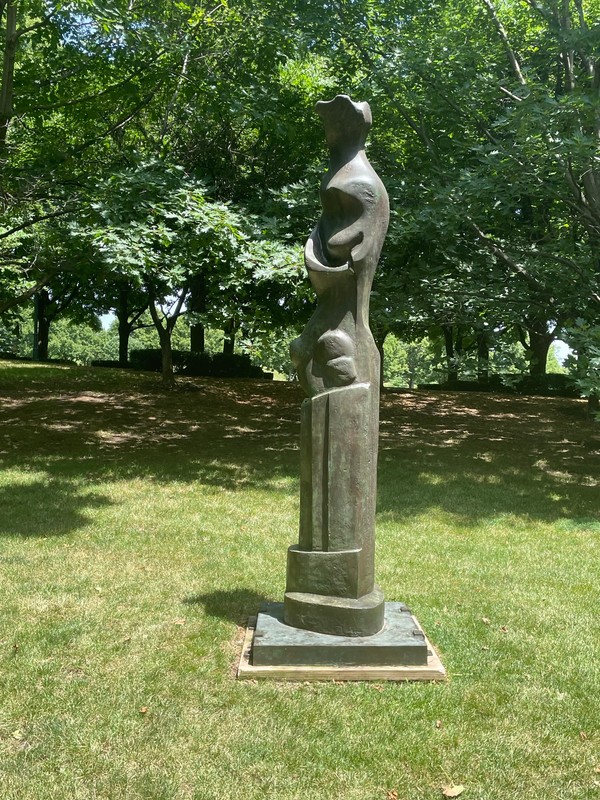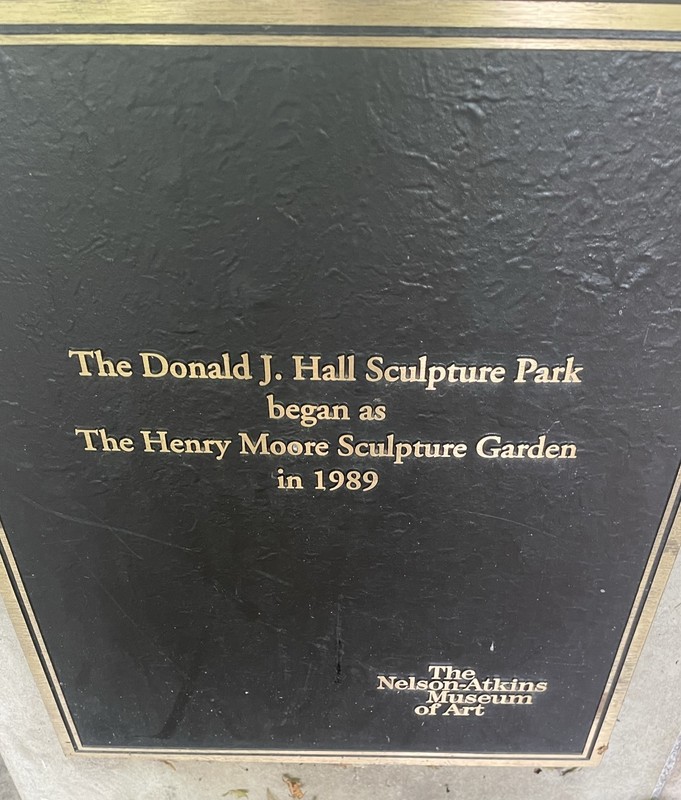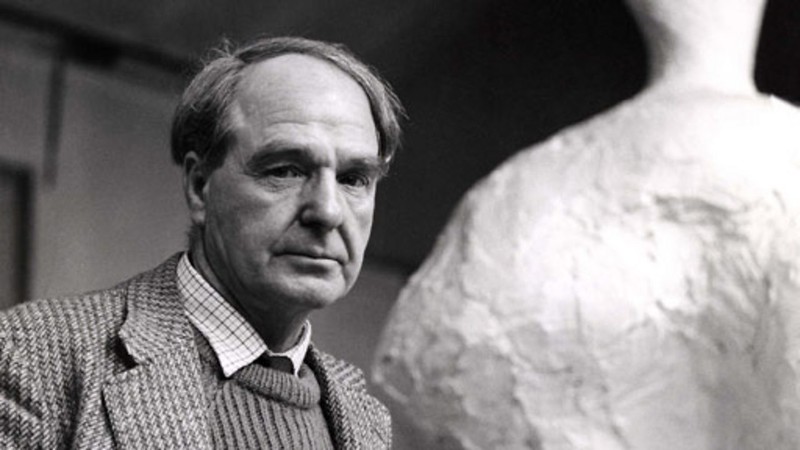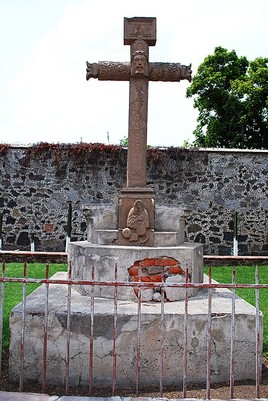Upright Motive No. 9
Introduction
Text-to-speech Audio
Created in 1979 by Henry Moore, Upright Motive No. 9 depicts an abstract female figure and resembles a Native American totem pole. The series of Upright Motives was first concepted in the mid-1950s and took influence from the British sculptor’s admiration for non-Western art. Often documenting his work and ideals, Moore acknowledged in an early journal that he must “Keep ever prominent the world tradition; the big view of sculpture,” as he experienced conflicting ideals with the traditional European art he had studied at Royal College and other cultural art he viewed on exhibit at the British Museum. Much of Moore’s work took on characteristics of ancient and indigenous art forms, including his most common form of the Reclining Figure. Upright No. 9 was a gift of the Hall Family Foundation.
Images
Upright Motive No. 9 by Henry Moore at the Nelson-Atkins Museum of Art, Kansas City, Missouri.

This plaque on the west side of the sculpture park serves as a reminder that this garden was named in honor of the artist Henry Moore in 1989. It was renamed in 2014 after the Hall Family Foundation's generous gift of their 84-piece sculpture collection.

Henry Moore (1898-1986)

The Atrial Cross seen by Henry Moore during a visit to Mexico in 1954 and used as inspiration for his series of Upright Motives.

Backstory and Context
Text-to-speech Audio
Best known as a pioneer for modern sculpture, Henry Moore (1989-1986) showed a talent in art as early as age 3. After serving for the British Army in World War I, he received an ex-servicemen's grant and quickly enrolled in the Leeds School of Art in the United Kingdom. He completed a two-year drawing course in one year before transferring to the prestigious Royal College of Art in London to study sculpture. While in London, Moore would often visit the British Museum and developed an interest in non-Western art. He became fascinated by cultural art from around the world, particularly Mexican, African, Oceanic, Peruvian and pre-Columbian art, as they differed greatly from the traditional Western art he was being taught to replicate at Royal College.
After graduating, Moore was granted a six-month travel scholarship to study the Old Masters in Italy. Upon his return to London, he went through a period of misery due to the conflicting ideals of his earlier interests and his recent re-exposure to European art. He later described his experience, “I was never more miserable in my life. Six months exposure to the master works of European art which I saw on my trip had stirred up a violent conflict with my previous ideals ... I found myself helpless and unable to work.” He then returned to the ancient Mexican exhibit at the British Museum to become re-inspired.
Commonly associating much of his work with the female form, some of Moore’s earliest works, in the 1920s, also often took on influence from traditions of non-Western cultures. This can be seen in the form of fertility, simplified animal forms, and masks, as well as the Chacmool which inspired his most commonly used form of the reclining figure.
The series of Upright Motives did not take shape until the mid-1950s. During a visit to Mexico in 1953, Moore visited carved stone ruins and was captivated, in particular, by a sixteen century stone cross. The following year, Moore created six upright maquettes for a contest for the facade of the English Electric Company Headquarters in London. He was then commissioned for sculptures for the courtyard of the new Olivetti building in Milan, where he created a series of upright forms to contrast the low, one-story building. While he did not secure either of the commissions, he wanted a change from his common reclining figure form and used the idea of the vertical sculptures in his work that followed. From 1955 to 1956, Moore created a series of 13 maquettes, called Upright Motives; five of which were enlarged to full size (numbers 1, 2, 5, 7, and 8) while the others were created in subsequent years.
Gallery Label
Upright Motive No. 9 represents an abstract human form emerging from a kind of pedestal. Henry Moore acknowledged that this form was inspired by the verticality of trees and Northwest Coast American Indian totem poles. Sculptors of Moore's generation were greatly influenced by the art of ancient and indigenous peoples, and Upright Motive No. 9 alludes to a millennium-long tradition of monolithic forms. The columnar form also refers to herms, the sculpted stone figures in Renaissance, Baroque and Rococo formal gardens.
A plaque near this piece serves as a reminder that this sculpture garden was named in honor of Henry Moore in 1989, as the Nelson-Atkins Museum of Art has one of the largest collections of Moore’s work in the world. Moore himself visited Kansas City in 1976 and consulted on placement for the city’s newly acquired sculpture, Sheep Piece, in which he rejected the original location, then was subsequently installed at The Nelson. In 2014, the garden was renamed to honor Donald J. Hall Sr., philanthropist and then-Chair of the Hall Family Foundation, who gifted Nelson-Atkins their 84-piece sculpture collection the same year.
Sources
Upright Motive No. 9, The Nelson-Atkins Museum of Art. Accessed September 16th, 2022. https://art.nelson-atkins.org/objects/6779/upright-motive-no-9.
Upright Motive No. 9, Henry Moore Catalogue. Accessed September 16th, 2022. https://catalogue.henry-moore.org/objects/15046/upright-motive-no9.
Alice Correia, ‘Upright Motive No.1: Glenkiln Cross 1955–6, cast 1958–60 by Henry Moore OM, CH’, catalogue entry, March 2013, in Henry Moore: Sculptural Process and Public Identity, Tate Research Publication, 2015. Accessed September 16th, 2022. https://www.tate.org.uk/art/research-publications/henry-moore/henry-moore-om-ch-upright-motive-no1-glenkiln-cross-r1151461.
Dawn Ades, ‘Henry Moore and World Sculpture’, in Henry Moore: Sculptural Process and Public Identity, Tate Research Publication, 2015. Accessed September 16th, 2022. https://www.tate.org.uk/art/research-publications/henry-moore/dawn-ades-henry-moore-and-world-sculpture-r1151458.
Discover & Research: Timeline, Henry Moore Foundation. Accessed September 16th, 2022. https://henry-moore.org/discover-and-research/discover-henry-moore/timeline/.
Photo by David Trowbridge
Photo by David Trowbridge
https://www.bbc.co.uk/archive/henry-moore/znkkf4j
